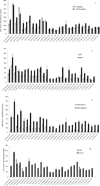Characterization of the arginolytic microflora provides insights into pH homeostasis in human oral biofilms
- PMID: 25634570
- PMCID: PMC4313619
- DOI: 10.1159/000365296
Characterization of the arginolytic microflora provides insights into pH homeostasis in human oral biofilms
Abstract
A selected group of oral bacteria commonly associated with dental health is capable of producing alkali via the arginine deiminase system (ADS), which has a profound impact on the pH of human oral biofilms. An increased risk for dental caries has been associated with reduced ADS activity of the bacteria in oral biofilms. Arginolytic bacterial strains from dental plaque samples of caries-free and caries-active adults were isolated and characterized to investigate the basis for differences in plaque ADS activity between individuals. Fifty-six ADS-positive bacterial strains were identified by 16S rRNA gene sequencing, and their ADS activity levels were compared under standard growth conditions. The spectrum of bacterial ADS activity ranged from 45.2 to 688.0 units (mg protein)(-1). Although Streptococcus sanguinis was the most prevalent species, other Streptococcus sp. were also represented. Biochemical assays carried out using 27 ADS-positive strains under conditions known to induce or repress ADS gene expression showed substantial variation in arginolytic activity in response to pH, oxygen and the availability of carbohydrate or arginine. This study reveals that the basis for the wide spectrum of arginolytic expression observed among clinical strains is, at least in part, attributable to differences in the regulation of the ADS within and between species. The results provide insights into the microbiological basis for intersubject differences in ADS activity in oral biofilms and enhance our understanding of dental caries as an ecologically driven disease in which arginine metabolism moderates plaque pH and promotes dental health.
Conflict of interest statement
The authors declare that there are no conflicts of interest.
Figures


Similar articles
-
Correlations of oral bacterial arginine and urea catabolism with caries experience.Oral Microbiol Immunol. 2009 Apr;24(2):89-95. doi: 10.1111/j.1399-302X.2008.00477.x. Oral Microbiol Immunol. 2009. PMID: 19239634 Free PMC article.
-
Diversity in Antagonistic Interactions between Commensal Oral Streptococci and Streptococcus mutans.Caries Res. 2018;52(1-2):88-101. doi: 10.1159/000479091. Epub 2017 Dec 20. Caries Res. 2018. PMID: 29258070 Free PMC article.
-
The effect of arginine on oral biofilm communities.Mol Oral Microbiol. 2014 Feb;29(1):45-54. doi: 10.1111/omi.12044. Epub 2013 Dec 2. Mol Oral Microbiol. 2014. PMID: 24289808 Free PMC article. Clinical Trial.
-
Potential Uses of Arginine in Dentistry.Adv Dent Res. 2018 Feb;29(1):98-103. doi: 10.1177/0022034517735294. Adv Dent Res. 2018. PMID: 29355411 Free PMC article. Review.
-
Arginine: A Weapon against Cariogenic Biofilm?Monogr Oral Sci. 2021;29:80-90. doi: 10.1159/000510203. Epub 2020 Dec 21. Monogr Oral Sci. 2021. PMID: 33427222 Review.
Cited by
-
Modulation of the Human Microbiome: Probiotics, Prebiotics, and Microbial Transplants.Adv Exp Med Biol. 2025;1472:277-294. doi: 10.1007/978-3-031-79146-8_17. Adv Exp Med Biol. 2025. PMID: 40111698 Review.
-
Tooth brushing using toothpaste containing theaflavins reduces the oral pathogenic bacteria in healthy adults.3 Biotech. 2021 Mar;11(3):150. doi: 10.1007/s13205-021-02699-7. Epub 2021 Mar 2. 3 Biotech. 2021. PMID: 33747700 Free PMC article.
-
Ecological Effect of Arginine on Oral Microbiota.Sci Rep. 2017 Aug 3;7(1):7206. doi: 10.1038/s41598-017-07042-w. Sci Rep. 2017. PMID: 28775282 Free PMC article.
-
The Oral-Gut Microbiome-Brain Axis in Cognition.Microorganisms. 2025 Apr 3;13(4):814. doi: 10.3390/microorganisms13040814. Microorganisms. 2025. PMID: 40284650 Free PMC article. Review.
-
Evidence for Proline Utilization by Oral Bacterial Biofilms Grown in Saliva.Front Microbiol. 2021 Jan 20;11:619968. doi: 10.3389/fmicb.2020.619968. eCollection 2020. Front Microbiol. 2021. PMID: 33552029 Free PMC article.
References
-
- Acevedo AM, Machado C, Rivera LE, Wolff M, Kleinberg I. The inhibitory effect of an arginine bicarbonate/calcium carbonate cavistat-containing dentifrice on the development of dental caries in venezuelan school children. J Clin Dent. 2005;16:63–70. - PubMed
-
- Acevedo AM, Montero M, Rojas-Sanchez F, Machado C, Rivera LE, Wolff M, Kleinberg I. Clinical evaluation of the ability of cavistat in a mint confection to inhibit the development of dental caries in children. J Clin Dent. 2008;19:1–8. - PubMed
Publication types
MeSH terms
Substances
Grants and funding
LinkOut - more resources
Full Text Sources
Other Literature Sources
Molecular Biology Databases
Research Materials

